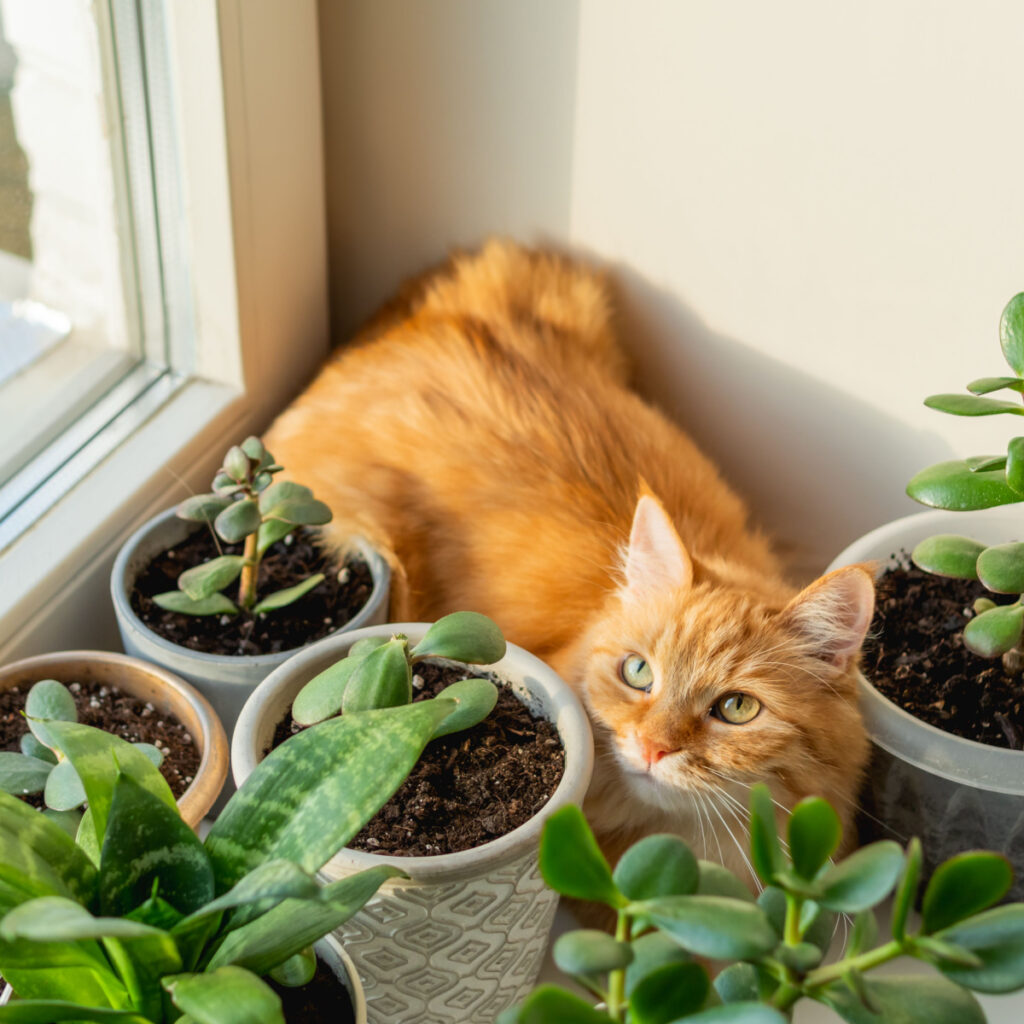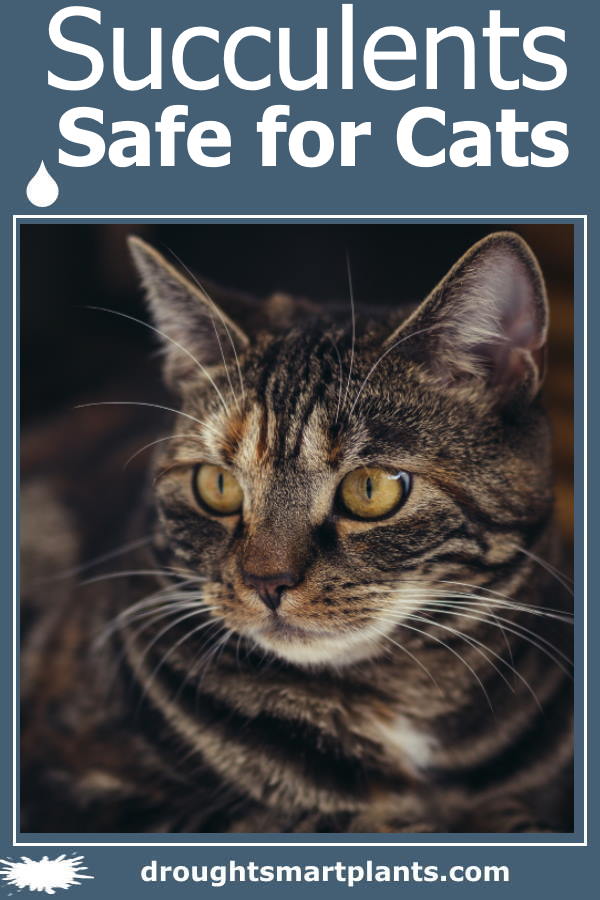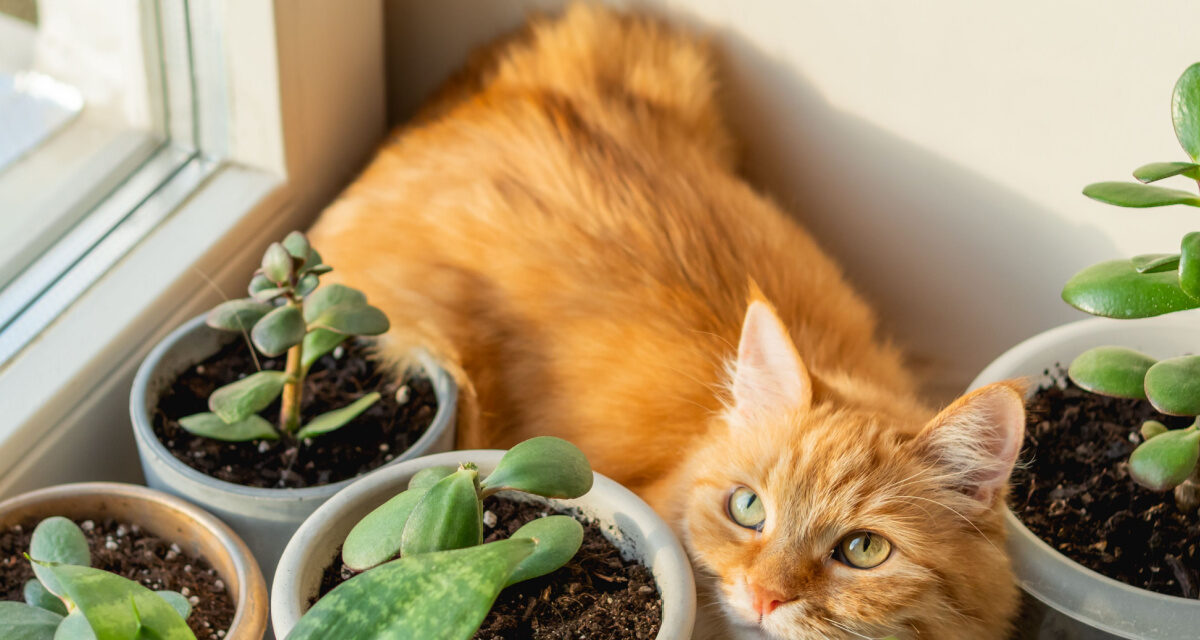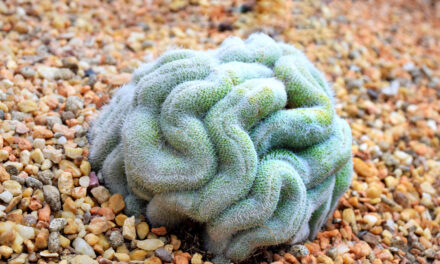When you’re a pet owner, everything comes down to safety: If your cat takes a bite of your succulent, what will happen? For the most part, you can rest easy knowing that there will likely be no negative side effects to your cat. Succulents are generally perfectly safe for cats and all household animals. Still want a more definitive list of plants? Check out the ones below for safe succulent options for your home.

Aloe
Aloe plants are safe for cats if they are eaten.
One concern that you may want to watch out for is that the edges of aloe leaves can be prickly or sharp. The leaves likely won’t break skin; in fact, I’ve had cats that use it for their own scratching post without any consequences.
Burro’s Tail
Burro’s Tail is another safe option for cats.
Burro’s Tail doesn’t have a smell, so your cat likely won’t be attracted to it in that respect. Rather, your cat may find that the stems of your Burro’s Tail make a great toy.
In this relationship, you should be more worried about your Burro’s Tail instead of your cat’s health!
Chinese Money Plant
Chinese Money Plants are a good option for cat-friendly households because they are tabletop plants.
You can easily keep an eye on this plant and keep it away from your cat because you can put it on a side table or on a bookshelf. If it is out of the way and not the center of attention, then your cat will likely ignore the plant.
If curiosity gets the better of your cat, you don’t have to worry that this plant might poison your cat.
Christmas Cactus
Of all the succulents on this list, the Christmas Cactus has one of the most showy flowers.
Your cat may be attracted to the hanging, colorful flowers on this plant. Unlike many other holiday plants, the Christmas Cactus – stems or flowers – are not toxic to your cats if they are eaten.
Ghost Plant
The worst thing that will happen to your cat if they interact with your Ghost Plant is that your cat will be covered in the powdery coating.
Ghost Plants have a special coating called pruinose that gives the Ghost Plants their unique white coloring. This coating is delicate, so any jostling from your cat will knock away the coating.
Haworthia
Haworthia are another “out of sight, out of mind” variety that your cat may not pay any attention to.
Haworthia are small and grow close to the soil, so they do not have any hanging tendrils or colorful flowers that will attract your cat. A particularly curious cat may try to dig up this plant, but that doesn’t mean anything bad will happen to your cat.
Hens and Chicks
Hens and Chicks are easy to grow and grow quickly.
Let’s say that your cat is a little monster and gets into your Hens and Chicks, even if you have them up and out of the way. Don’t worry! Hens and Chicks grow in nearly any kind of soil as long as it has enough sunlight, so you’ll quickly be able to regrow your Hens and Chicks – without putting your cat in danger.
Jade Plant
Jade Plants could be attractive to your cat just because they can look like a bush or have some sparse branches. In fact, your Jade Plant might even look a little bit like your cat tree, just smaller.
Jade Plants are completely safe for cats, so even if your succulent falls victim to the clutches of your cat, you don’t have to be concerned about if the stems or leaves are toxic.
Living Stones
Living Stones succulents are not in any way poisonous to your cats – or any other animals in your home.
Are you looking for a succulent that is almost guaranteed to be left alone by your cat? Living Stones are the way to go! Not only are Living Stones succulents low to the ground, they also look like, well, rocks, so your cat may not be too interested in these succulents.
Panda Plant
Panda Plants can fall prey to your cat, but they are not toxic to cats and other animals.
Panda Plant stems stick straight up, so I wouldn’t be surprised if your cat gets so curious that they want to take a bite of one of the stems.
The worst thing that is going to happen to your cat is that he or she may be confused by the fuzzy texture of the Panda Plant leaves.
Pencil Cactus
Pencil cacti look scary with their garish stems, but they are totally safe around animals as long as they are not broken.
Cats are likely to break parts of the Pencil cactus off because of the shapes of it. The stems are also pretty delicate, so they’re gong to be easy to break. This is the one succulent on this list that you’re not going to want to be eaten because, while the succulent is not poisonous, the sap can cause reactions.
Ponytail Palm
Ponytail Palms are also rubber-stamped to be safe around cats.
Your cats might even find the wispy palms to be one of the best toys that your cat is going to find in the house!
String of Buttons
Another small succulent, the String of Buttons is totally safe to be around your cat.
Like I’ve said over and over, the String of Buttons is small, so your cat is likely to not even notice that there is a succulent nearby!
String of Pearls
Though safe, String of Pearls succulents scream “cat toy.”
With small balls on stems, your cat is almost guaranteed to assume that this is a new cat toy that you’ve brought home.
The pot that your succulent is in may be more dangerous than the succulent itself!
Zebra Plants
And finally – the Zebra Plant. Another beautiful succulent that you don’t have to hide from your cat.
Your cat may show some interest in the large leaves of your Zebra Plant, but the texture of the leaves probably won’t be interesting enough for your cat to munch on when he’s not supposed to.
Even if they take a nibble
The trend of growing succulents is not going away, neither is the ownership of cats. How do you combine both in a way that’s safe for both plant and kitty?

It’s surprising (and rather shocking too) that box stores and other shops sell all kinds of rather poisonous succulent plants, just trying to keep up with the trend.
It’s a bad idea to buy any succulent plant that comes without a label, especially if you’re just starting out.
You just never know what you’re getting!
However, you’ve decided to ignore this advice and you bought some plants without names.
Now you need to find out what they are, especially if you have a cat that likes to nibble on unknown plants. See the page about succulent plant identification to help with that.
If you look for specific feline friendly plants, there are lots that are easy to grow, beautiful, and won’t send your kitty into an expensive visit to the vets.
If this post catches you before you go to the box store, garden center or anywhere else that has plants, great! You can print off the list and take it with you.
This list is by no means every single plant that is safe for cats, even if they have to taste a leaf or two.
Cats and gardens have been co-existing peacefully for eons and I’m sure they’ll continue to get along just fine for a long time to come.
Aeshenanthus (Lipstick Plant, Goldfish Plant)
Echeveria (Mexican Snowball, Hens and Chickens, Mexican Firecracker)
Sedum morganianum (Burros Tail Sedum)
Schlumbergera; Christmas Cactus (non toxic to cats, poisonous to dogs)
Sempervivum (Hens and Chicks)
Haworthia (sometimes called ‘pearl plant’)
Dinteranthus, Lithops (Pebble plants, Living Stones)
x Pachyveria species (Ghost Plant)
Delosperma (Ice Plant)
Hylocereus (Queen of the Night, Night Blooming Cereus)
Cryptanthus (Earth Star Plant)



